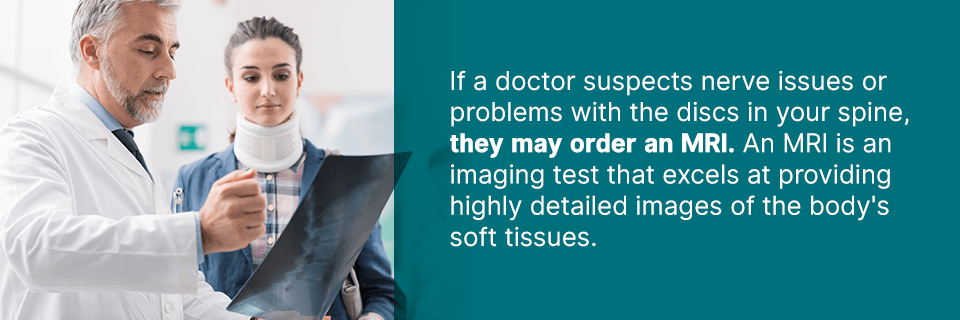Types of X-rays

It can feel scary when your doctor orders an x-ray, and no one wants to hear they need further testing. However, x-rays are quick, painless procedures that help your doctor identify the cause of your symptoms, so you can get the treatment you need. Doctors use different types of x-rays to diagnose everything from minor bone fractures to potentially life-threatening diseases. Overall, x-rays are a critical tool that helps save lives.
We’ll explore the different types of x-rays doctors commonly order to help their patients get the proper care. If you have any questions about the x-ray process, reach out to us at Envision Imaging.
Jump to Sections:
- What is an X-Ray?
- What are the Different Types of X-Rays?
- Chest X-Ray
- Abdominal X-Ray
- Kidney, Ureter and Bladder X-Ray
- Neck X-Ray
- Hand X-Ray
- Joint X-Ray
- Skull X-Ray
What Is an X-ray?
An x-ray is a type of electromagnetic radiation. The light we see is also a form of electromagnetic radiation. However, unlike visible light, x-rays have much more energy, so they can pass through the human body. When x-rays pass through the part of your body under examination, they produce an image on film.
If you’ve ever seen an x-ray image, you can probably recall it looked black and white. This is because dense materials like bones absorb x-rays and appear white on an image. Soft tissues, such as organs and muscles, allow x-rays to pass through and therefore show up black on an x-ray. A doctor will analyze the hard and soft tissues shown in your x-ray to determine the cause of your symptoms. This type of imaging test enables doctors to see inside your body without performing surgery.
What Are the Different Types of X-rays?
Sometimes, blood work and a physical exam do not provide enough clues for a doctor to figure out what’s causing your symptoms. When a doctor needs more information to make an accurate diagnosis, they’ll use an image-producing diagnostic tool, such as an x-ray. Here are the different types of commonly ordered medical x-rays and the reasons why they are performed.
1. Chest X-ray
If you’re having trouble breathing, experiencing a persistent cough or feeling pain in your chest, your doctor may order a chest x-ray. A chest x-ray takes an image of your upper body and the bones and organs inside, including the heart, lungs and ribs. With a chest x-ray, your doctor will look for conditions such as pneumonia, tuberculosis, lung cancer, heart size problems, rib or spine fractures, or any chest or lung disease.
During the imaging procedure, you’ll stand in front of the x-ray machine and face forward for one image. Usually, the x-ray technologist will then ask you to stand sideways for a second image. You’ll be asked to hold your breath for a few seconds as the x-ray is taken. This helps you stay still and prevents a blurry image.
Your chest x-ray will allow your doctor to quickly and easily look at some of your body’s vital organs.
2. Abdominal X-ray
An x-ray of the abdomen provides a look at organs such as the intestines, stomach and spleen. Your doctor might order an abdominal x-ray if you are suffering from unexplained stomach pain or nausea. This tool will help them identify conditions that might be causing your discomfort, such as kidney stones, an intestinal blockage or any injury to abdominal tissue.
During this type of x-ray, you’ll likely lie flat on a table with the x-ray machine situated over your abdomen. A technologist will be there to assist you onto and off of the table. They will then capture an image of your front as you hold your breath for a few seconds. Depending on your symptoms, they may wish to take x-rays of your sides or as you stand.
After your doctor examines your x-ray and finds the cause for your abdominal pain, they can help you feel healthy again, or order further testing if needed.
3. Kidney, Ureter and Bladder X-ray
A kidney, ureter and bladder (KUB) x-ray is taken to look for issues in the urinary system as well as gastrointestinal problems. This may be the first test used to diagnose a urinary condition.
With this type of x-ray, your doctor can evaluate your urinary tract and gain insight into the shape, size and position of your kidneys, ureters and bladder. They may determine the presence of kidney or ureteral stones or other reasons for your symptoms.
Depending on the view needed, you may be told to stand, lie flat or be situated on your side during the x-ray, and you may have to switch positions. A trained technologist will be available to help you feel comfortable throughout the procedure.
4. Neck X-ray
If you’re experiencing persistent pain, numbness or weakness in your neck, your doctor might order a neck x-ray. A neck x-ray enables a doctor to view the vertebrae, or spinal bones, in your neck. They can use the x-ray to look for a bone fracture, dislocated joint, infection or inflammation. If a doctor suspects nerve issues or problems with the discs in your spine, they may order an MRI. An MRI is an imaging test that excels at providing highly detailed images of the body’s soft tissues.
During a neck x-ray, you will lie on a table and be asked to change positions until your doctor gets the images they need. Typically, a neck x-ray procedure involves two to seven images. A skilled technologist will be by your side to ensure you’re as comfortable as possible while you switch positions.

5. Hand X-ray
Your doctor might order a hand x-ray if you’re experiencing pain in your hand or suffered an injury to the area. A hand x-ray will show your doctor if you have any broken bones, joint abnormalities, bone tumors or conditions such as an infection, arthritis or tendinitis.
During a hand x-ray, you’ll be asked to place your hand flat on a table and keep it still as the image is taken. You may need to change the position of your hand a few times to provide the necessary images. The technologist will do everything they can to complete the x-ray quickly.
6. Joint X-ray
A joint x-ray is used to investigate discomfort in your knees, shoulders, hips, ankles or wrists. Your doctor will look for signs of arthritis, fractures, inflammation and numerous other conditions that may cause joint pain such as gout, osteoarthritis or rheumatoid arthritis. The technologist will help you position the joint so they can capture an accurate image. They may need to reposition the joint in a few poses to get more pictures.
7. Skull X-ray
If you experienced a head injury or show symptoms of a skull-related condition, your doctor might order a skull x-ray. A skull x-ray enables your doctor to check the many bones of your head structure, such as facial bones and cranial bones. They can look for conditions such as tumors, sinus or ear infections, fractures, bone loss or soft tissue movement within the skull.
During a skull x-ray, you may be asked to lie on a table or sit in a chair. The technologist will help you move your head in different positions to capture several x-ray images.
Choose Envision Imaging
If your doctor ordered an x-ray to find out the cause of your symptoms, you might be imagining the worst. We understand. No one wants to worry about getting x-ray tests done while they’re in pain or feel ill. At an Envision Imaging center, our compassionate, skilled technologists will help you through any type of x-ray or scan, so you and your doctor can get to the root of the issue fast.
We focus on making every patient feel cared for, listened to and comforted during each procedure. Using the highest quality technology, we produce accurate x-rays and other imaging results as quickly and conveniently as possible, all while providing the utmost level of care. If you need an x-ray to diagnose a health problem or injury, schedule an appointment at an Envision Imaging center today.
Sources
- https://www.nibib.nih.gov/science-education/science-topics/x-rays
- https://4rai.com/blog/different-types-of-x-ray-and-mri-exams-know-your-testing
- https://www.wonderopolis.org/wonder/how-does-an-x-ray-work
- https://www.envrad.com/services/x-ray/
- https://medlineplus.gov/ency/article/003337.htm
- https://medlineplus.gov/ency/article/003804.htm
- https://www.lalpathlabs.com/blog/what-are-the-different-types-of-x-rays-and-their-usage/
- https://medlineplus.gov/ency/article/003815.htm
- https://medlineplus.gov/ency/article/003805.htm
- https://www.hopkinsmedicine.org/health/treatment-tests-and-therapies/xrays-of-the-extremities
- https://medlineplus.gov/ency/article/003811.htm
- https://medlineplus.gov/ency/article/003810.htm
- https://medlineplus.gov/ency/article/003802.htm
- https://www.hopkinsmedicine.org/health/treatment-tests-and-therapies/kidney-ureter-and-bladder-xray
- https://www.envrad.com/locations/
- http://www.qrg.northwestern.edu/projects/vss/docs/space-environment/2-what-is-electromagnetic-radiation.html
- https://www.envrad.com/services/mri-scans/
- https://www.urmc.rochester.edu/encyclopedia/content.aspx?contenttypeid=92&contentid=P07647
- https://www.envrad.com/about-us/why-choose-us/



